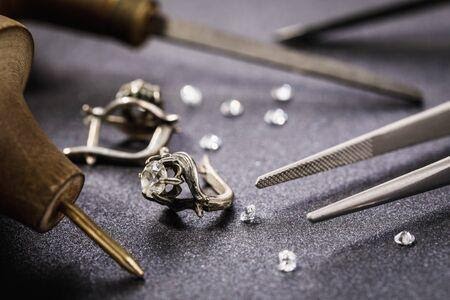
Were you ever curious about the making a diamond ring?
If you're engaged and wearing an engagement ring, you've probably wondered about the making it.
The ring's band is adorned with a plethora of tiny diamonds, making it clear that making jewelry of this caliber is no easy task. When working with small and delicate materials, it is especially important to exercise patience and maintain a steady hand.
A new world of possibilities has opened up for ring and jewelry makers thanks to 3D printing. This means that custom orders can be produced and delivered much more quickly, even if the designs are complex and difficult. See how diamond rings have been made traditionally and more recently.
A beautiful diamond ring begins with cutting the metal to the proper size. If the ring's band is going to have any texture, now is the time to add it. A mallet or hammer should be used depending on the style of finish desired in the ring's band.. With a ball pein and a flat head, the jobbing hammer can be used to create two different textures with one tool.
A ring triblet can be used to shape the metal after it has been cut to the desired length and width. A stainless steel triblet will hold its shape better than the plastic triblets commonly found on fashion rings. When the metal is bent around the triblet and hammered into shape with a jewelry hammer, the ring shank (or bottom band) becomes stronger and harder as more pressure is exerted on all sides.
It's time to begin designing the claw that will eventually hold the diamond. Another strip of metal is cut into four equal pieces, and this time the claw shape is entirely determined by the diamond cut, and must be adjusted accordingly. The final step is to solder, file, and polish the finished claw. Once again, a quality triblet will be used to shape and bend the ring at this point.
A GRS engraving block can be used to set diamonds or gemstones around the ring shank. Ring makers have more options for setting delicate stones because of its unique shape, which allows for more angles. The "bezel setting" is the most common method of setting, and it involves drilling small holes in metal. A "projecting lip" is built around the groves to keep the stones in place after they have been placed. A ball bur, a thin and delicate drill with a variety of heads, can be used to create these groves (also known as concave cuts).
When the final polishing is complete, the diamond is ready to be placed in the ring's claw and given to the lucky recipient!
Wax carving and casting, a centuries-old method of ring making, is another traditional method. In fact, the first use of this method dates back to the days of primitive craftsmen, when plaster and stone were used as moulds. If you look at your ring, you wouldn't be able to tell that it was cast in wax. The "lost wax process" gets its name from the fact that when you put your ring on your finger, there will be no trace of the method.
Designers of jewelry work with wax to create an exact replica of the ring they intend to create. A plaster-like substance is poured into a metal flask after the model has been sculpted to its final form. After the model has dried out, it is placed in a high-temperature oven to harden it further. There will be nothing left but a hollow impression of your initial design after the wax is completely burned away in this "lost wax process."
The liquid metal of your choice is then poured into the mold and solidified. Centrifugal or vacuum casting can be used, depending on the jewelry maker. To remove the ring from its mold after it has cooled, carefully break away the plaster holding it together. Polishing and refining can begin now that the ring has been made. This is the time to begin the stone setting process if the ring will be embellished with precious stones or diamonds.

